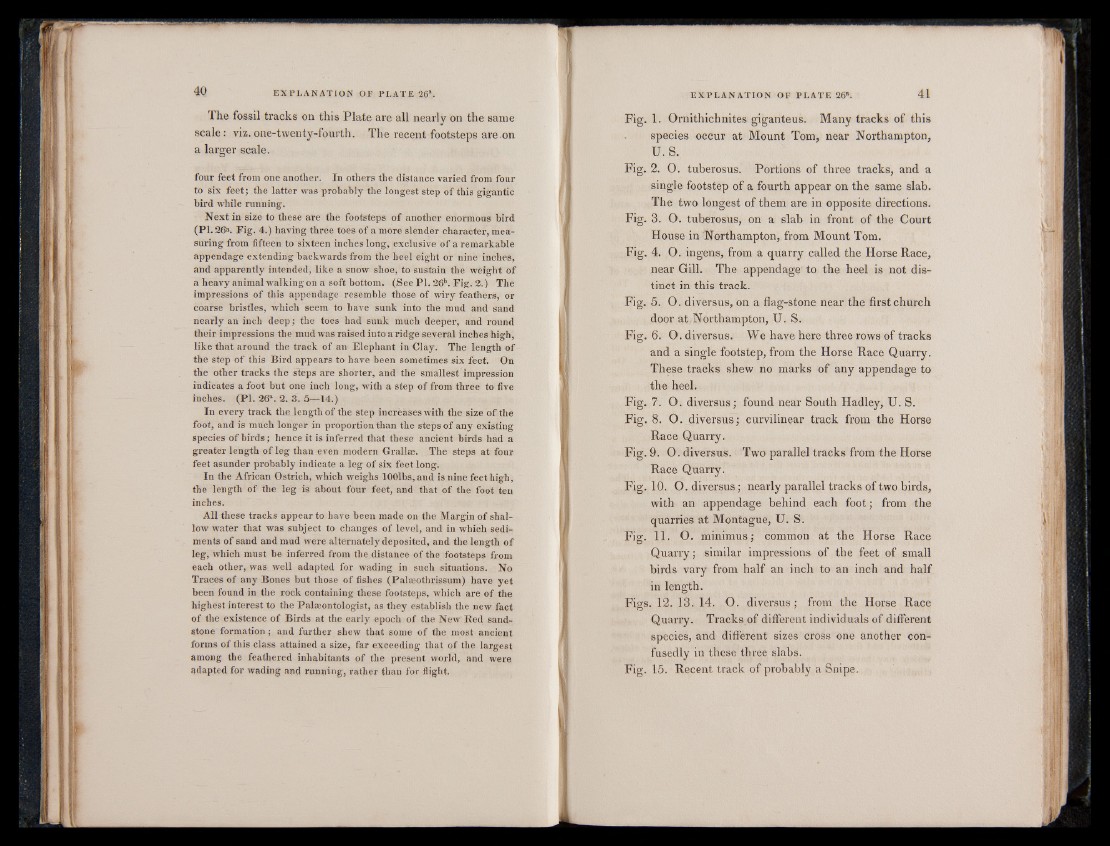
The fossil tracks on this Plate are all nearly on the same
scale: viz.one-twenty-fourth. The recent footsteps are.on
a larger scale.
four feet from one another. In others the distance varied from four
to six feet; the latter was probably the longest step of this gigantic
bird while running.
Next in size to these are the footsteps of another enormous bird
(P1.263. Fig. 4.) having three toes of a more slender character, measuring
from fifteen to sixteen inches long, exclusive of a remarkable
appendage extending backwards from the heel eight or nine inches,
and apparently intended, like a snow shoe, to sustain the weight of
a heavy animal walking on a soft hottom. (See PI. 26b. Fig. 2.) The
impressions of this appendage resemble those of wiry feathers, or
coarse bristles, which seem to have sunk into the mud and sand
nearly an inch deep; the toes had sunk much deeper, and round
their impressions the mud was raised into a ridge several inches high,
like that around the track of an Elephant in Clay. The length of
the step of this Bird appears to have been sometimes six feet. On
the other tracks the steps are shorter, and the smallest impression
indicates a foot but one inch long, with a step of from three to five
inches. (PI. 26*. 2. 3. 6—14.)
In every track the length of the step increases with the size of the
foot, and is much longer in proportion than the steps of any existing
species of birds; hence it is inferred that these ancient birds had a
greater length of leg than even modern Grallas. The steps at four
feet asunder probably indicate a leg of six feet long.
In the African Ostrich, which weighs lOOlhs, and is nine feet high,
the length of the leg is about four feet, and that of the foot ten
inches.
All these tracks appear to have been made on the Margin of shallow
water that was subject to changes of level, and in which sediments
of sand and mud were alternately deposited, and the length of
leg, which must be inferred from the distance of the footsteps from
each other, was well adapted for wading in such situations. No
Traces of any Bones but those of fishes (Palaeothrissum) have yet
been found in the rock containing these footsteps, which are of the
highest interest to the Palaeontologist, as they establish the new fact
of the existence of Birds at the early epoch of the New Red sandstone
formation ; and further shew that some of the most ancient
forms of this class attained a size, far exceeding that of the largest
among the feathered inhabitants of the present world, and were
adapted for wading and running, rather than for flight.
Fig. 1. Ornithichnites giganteus. Many tracks of this
species occur at Mount Tom, near Northampton,
U. S.
Fig. 2. O. tuberosus. Portions of three tracks, and a
single footstep of a fourth appear on the same slab.
The two longest of them are in opposite directions.
Fig. 3. O. tuberosus, on a slab in front of the Court
House in Northampton, from Mount Tom.
Fig. 4. O. ingens, from a quarry called the Horse Race,
near Gill. The appendage to the heel is not distinct
in this track.
Fig. 5. O. diversus, on a flag-stone near the first church
door at,Northampton, U. S.
Fig. 6. O. diversus. We have here three rows of tracks
and a single footstep, from the Horse Race Quarry.
These tracks shew no marks of any appendage to
the heel.
Fig. 7. O. diversus; found near South Hadley, U. S.
Fig. 8. O. diversus; curvilinear track from the Horse
Race Quarry.
Fig. 9. O. diversus. Two parallel tracks from the Horse
Race Quarry.
Fig. 10. O. diversus; nearly parallel tracks of two birds,
with an appendage behind each foot; from the
quarries at Montague, U. S.
Fig. 11. O. minimus; common at the Horse Race
Quarry; similar impressions of the feet of small
birds vary from half an inch to an inch and half
in length.
Figs. 12. 13. 14. O. diversus; from the Horse Race
Quarry. Tracks of different individuals of different
species, and different sizes cross one another confusedly
in these three slabs.
Fig. 15. Recent track of probably a Snipe.